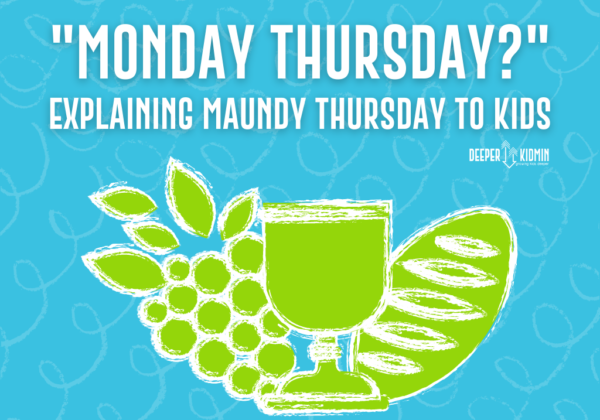
“Monday Thursday?! No, Ms. Brittany.” *sigh* “It goes Monday, TUESday!” a 2nd grader in my small group corrected me. She thought I was naming the days of the week all out of order and was appalled at my lack of common sense knowledge.
I promise: I do know the order of the days of the week. We were talking about Holy Week, and I referenced Maundy Thursday (which does kind of sound like “Monday Thursday” honestly). Her exasperated correction led to a short but insightful conversation for our small group about Maundy Thursday: what it means, why we celebrate it, and even why it’s called “Maundy.”
I have to admit: I didn’t know all the answers to their questions. There were times I had to say “I don’t know, but I’ll look it up and get back to you next week.” I knew the basics but wanted to know more, so I did some research and dove headfirst into the richness of this specific day. If you’ve got kids asking questions about Maundy Thursday too or just want to better explain this day to kids, here’s what I’d focus on:
The name “Maundy” Thursday comes from the Latin word for “command,” and Maundy Thursday refers to Jesus’ command to the disciples to “love one another as I have loved you” (John 13:34). Jesus himself goes on to model this commandment through 3 significant details/actions:
- The Last Supper – The Thursday before Jesus died, he shared a final meal with his disciples, known as the Last Supper. But this meal wasn’t just any regular meal. It was a Passover meal. The Passover meal is a yearly festival/celebration that remembers when God set His people free from slavery in Egypt after the 10 plagues. The Jews are spared from the final plague of the killing of every firstborn son by painting the blood of a lamb over their doors. God “passed over” any home marked with the blood of the sacrificial lamb. Understanding and connecting the original Passover story to the Last Supper helps us see that Jesus is the ultimate sacrificial lamb. When kids see this connection between the Old Testament and New Testament, it helps them connect the larger story of the Bible.
- The First Communion – In Mark 14:2-24, we see Jesus offer, for the very first time, the sacrament of Communion. The broken bread is a symbol of his broken body, and the wine is a symbol of his blood poured out for us. The church continues to use the sacrament of Communion as a way to remember Jesus’ sacrifice on the cross. Whether your church allows children to participate in Communion or not, it’s important that we teach kids about this practice of the church. Children must know that Communion allows us to remember Christ’s sacrifice and connect with Him through reflection and prayer. Encourage children to consider confessing their sins to God and asking for a clean heart before partaking in Communion. Teach children that Communion is one aspect or part of worship – both on a personal level and on a community-of-believers level.
- Washing the Disciples’ Feet – John 13:1-17 shows us how Jesus humbled himself to wash the disciples’ feet during the Passover meal. Many churches even include a time of foot washing in their Maundy Thursday service. We have to help kids understand the significance of this foot washing as an example of humility, servant leadership, and love. Explaining the cultural context of washing feet can help kids understand its significance. Depending on the ages of your children and the size of your group, you may even consider giving kids the opportunity to wash one another’s feet, even if it’s just with a baby wipe or a wet washcloth. Jesus tells the disciples to do what He has done, showing Jesus’ call on all of our lives to serve and love others.
Jesus knew what was coming on Good Friday – and he chose to show love anyway. Whether you have a Maundy Thursday service at your church or you provide a simple family devotion to help your families remember the events of Holy Week at home, it’s important that we teach families about these events that not only prepared Jesus and his disciples for what was to come, but also shaped the practices of the Church today.

Leave a comment
You must be logged in to post a comment.